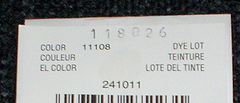
Dye lot
Encyclopedia

Dyeing
Dyeing is the process of adding color to textile products like fibers, yarns, and fabrics. Dyeing is normally done in a special solution containing dyes and particular chemical material. After dyeing, dye molecules have uncut Chemical bond with fiber molecules. The temperature and time controlling...
of yarn
Yarn
Yarn is a long continuous length of interlocked fibres, suitable for use in the production of textiles, sewing, crocheting, knitting, weaving, embroidery and ropemaking. Thread is a type of yarn intended for sewing by hand or machine. Modern manufactured sewing threads may be finished with wax or...
to identify yarn that received its coloration in the same vat
Vat
Vat or VAT may refer to:* A type of container such as a barrel, storage tank, or tub, often constructed of welded sheet stainless steel, and used for holding, storing, and processing liquids such as milk, wine, and beer...
at the same time. Yarn manufacturers assign each lot a unique identification number and stamp it on the label before shipping. Slight differences in temperature, dyeing time, and other factors can result in different shades of the same color between different dye lots of otherwise identical production. Although the component elements of a dye lot number are of interest only for internal business recordkeeping, retail yarn consumers have an interest in ensuring that they purchase a given color of yarn from identical dye lots.
The dye lot problem

Knitting
Knitting is a method by which thread or yarn may be turned into cloth or other fine crafts. Knitted fabric consists of consecutive rows of loops, called stitches. As each row progresses, a new loop is pulled through an existing loop. The active stitches are held on a needle until another loop can...
and crocheters because the use of yarn from different dye lots can spoil the appearance of handmade textile
Textile
A textile or cloth is a flexible woven material consisting of a network of natural or artificial fibres often referred to as thread or yarn. Yarn is produced by spinning raw fibres of wool, flax, cotton, or other material to produce long strands...
s. These shade variations may be subtle enough to be undetectable on a store shelf, but actual differences in shade becomes apparent during knitting or crocheting or after washing. Unmatched dye lots are a significant problem to knitters and crocheters because the problem manifests after days or weeks of labor, by which time the supplier's stock of the original dye lot may have been depleted.
The usual solution to the dye lot dilemma is to purchase sufficient skein
Skein
Skein may refer to:* A flock of geese or ducks in V formation flight* A wound ball of yarn with a center pull strand, see hank* TV Series, used part of Variety's slanguage.* Skein dubh, a Scottish knife* Skein module, a mathematical concept...
s from the identical lot before beginning a project. Published craft designs provide estimated material quantities for this purpose. If the crafter neglects to check dye lots or a design underestimates the yarn requirement, or if a store lacks sufficient quantities of a single lot, then one compromise solution is to construct the item so that a contrasting color separates yarns from different lots. Other workarounds are to change stitch patterns for the odd lot, to use the odd lot for a border or other separate and contrasting element, or to conceal the juncture between two dye lots with a surface embellishment.
No dye lot yarn
A few manufacturers produce yarn without a dye lot designation by dyeing fibers before spinning. This has the advantage of avoiding the dye lot problem, but the yarn is usually a discount grade of acrylic. No dye lot yarn is suitable for practice and some projects, but not to create fine apparel.Dye lot in other uses
Use of the same dye lot or run number may also be important in other applications, such as: WallpaperWallpaper
Wallpaper is a kind of material used to cover and decorate the interior walls of homes, offices, and other buildings; it is one aspect of interior decoration. It is usually sold in rolls and is put onto a wall using wallpaper paste...
, fabrics for drapes and other uses, carpets, flooring, tiles, etc.

